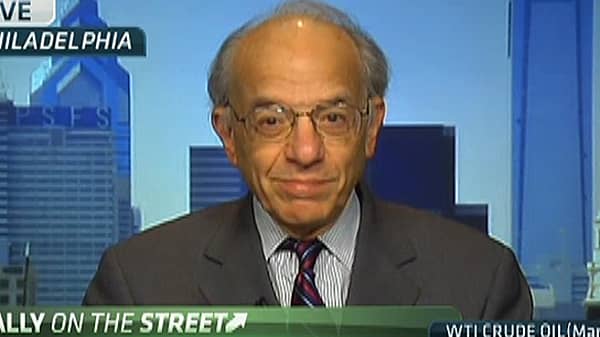Indeed, some investors see the Dow's rally as a direct function of the Fed's efforts to re-inflate growth, rather than a product of economic fundamentals.
"Certainly given where interest rates are...the Fed is trying to push you into equities," said Eric Stein, portfolio manager at Eaton Vance. "There's a question of how much can we get with actual growth, given the fact that you have such a poor" showing of gross domestic product, he said.
"The market wants QE," Stein said, speaking about the Fed's quantitative easing program, which is funneling about $85 billion a month via bond buying into the world's largest economy.
(Read more: Why Inflation Could Eat Into Stock Gains: Kyle Bass)
The Dow Jones Industrial Average rose by more than 150 points, ending the day above 14,000 — its highest level in more than five years and less than 200 points away from an all-time high. The S&P 500 Index rose by about 15 points, ending above 1,513, while the the Nasdaq added nearly 37 points to close above 3,179. The averages posted their fifth consecutive week of gains.
Among sector leaders were telecoms and financials, with all ten S&P 500 large cap sectors trading higher. Dow components that also helped grease the wheels of the rally included Bank of America, United Technologies, Verizon and AT&T.
(Read more: Dow Breaks 14,000 Finally; What's Next for Market)
Friday's employment data was a welcome salve for some skittish investors who had begun to doubt the staying power of the recovery — particularly in the wake of last quarter's surprising economic contraction. However, doubts about the momentum behind the market's rally continued to linger.
(Read more: Why Talk of a 'Great Rotation' May Be Overblown)
"It's not the big pop that one would think you'd get, and I for one think that's good," Jack Bogle, chairman and Founder of The Vanguard Group, told CNBC. He added that mutual funds piling into equities could be "a very negative sign for the market."
Pointing out that the Nasdaq is still "fully a third below its high," Bogle added that "the signs were mixed. I don't think the economic signs are going to change very much." He said he expects the economy to expand by 2-2.5 percent in 2013.
The rally was pushed higher by December construction data and better than expected U.S. manufacturing data, which confirmed generally buoyant global manufacturing data reported during overseas trading hours.
The employment report came as welcome news in a market that was jolted earlier this week by an unexpectedly weak GDP report. While most corporate earnings have been stronger than expected, some market watchers have begun to worry that the recovery was losing steam.
Corporate America is in the thick of earnings season, most of which have met or exceeded expectations and helped keep a floor under major benchmarks. Still, most companies remain cautious about the outlook for 2013, as battles over taxes, spending and debt heat up in Washington with little immediate resolution in sight.
Oil and gas Exxon Mobil saw its fourth quarter profit surge by six percent, helped by stronger chemical and refining business and beating Wall Street's estimates. Exxon, which last week reclaimed the mantle of world's largest company from beaten-down tech giant Apple, saw its stock flatline at $90 in Friday's trading.
Thus far, Apple is the S&P 500's worst performing stock, falling a steep 14.5 percent. In Friday's trading, the stock failed to mimic the gains of the broader stock market, modestly lower on the day near $452.
Excitement over the Dow's rally helped drag other stocks higher, such as Google, which set a new all time high just as Apple remains mired near its lowest levels in a year. The search giant's shares settled above $775. Procter & Gamble and Honeywell were also stocks which hit historic highs.




